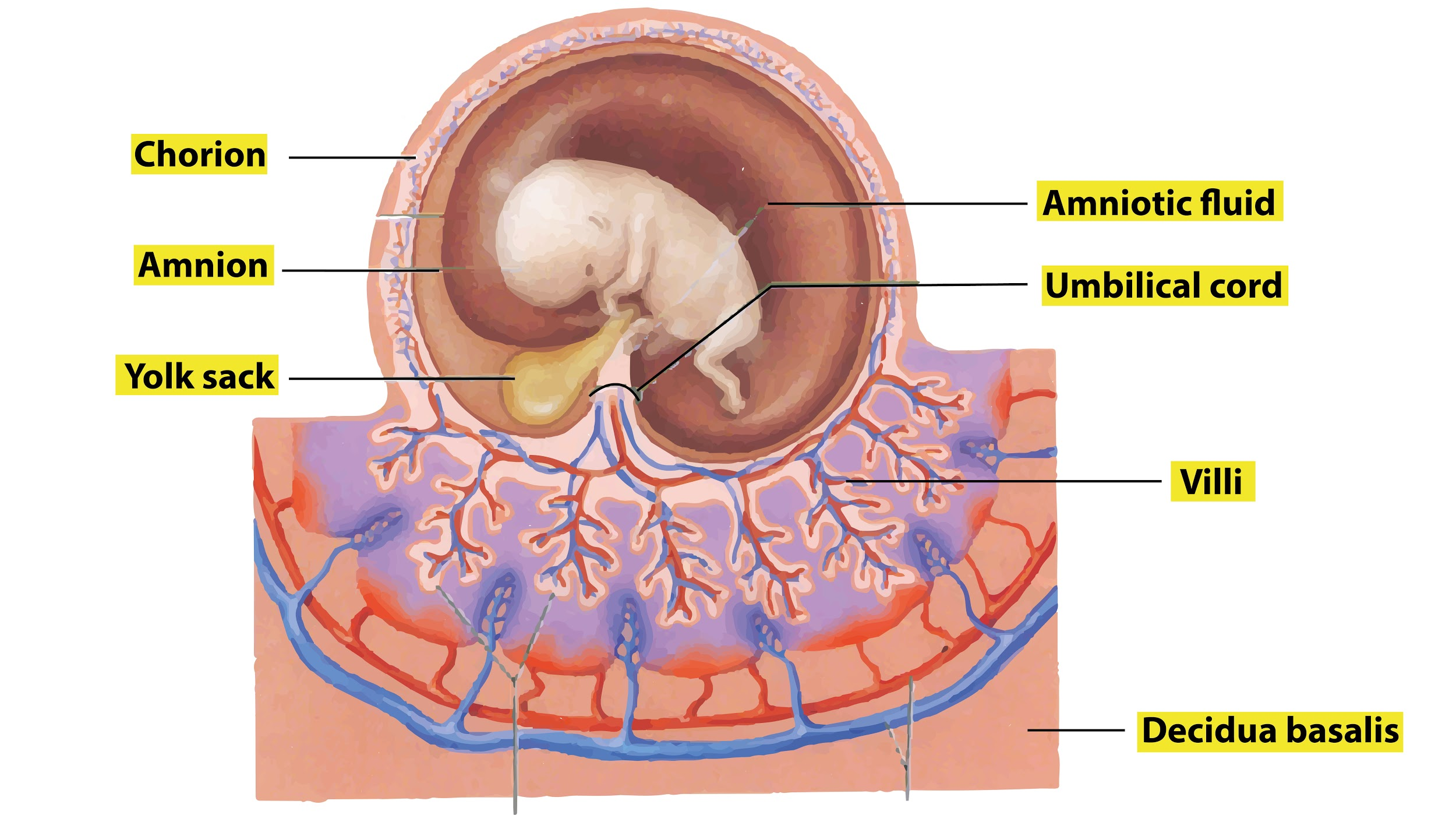
Which of the following statements is wrong?
(a) Amnion is the outer layer containing amniotic fluid that acts as a shock absorber for the embryo
(b) Amnion and chorion develop as upward projecting folds of somatopleure called amniotic folds
(c) In mammals, the allantois is not excretory in function
(d) Yolk sac is a foetal membrane that helps in the nourishment of embryos in general.
(e) Chorioallantoic membrane develops villi and contributes much to the development of the placenta.
Answer
571.2k+ views
Hint: The fetal surface side is smooth and shiny which is covered by amnion. The umbilical vessels radiate from the umbilical cord where they branch on the fetal surface to form chorionic vessels.
Complete step by step answer:
Amniotic membrane: It is a membrane that encloses an amniotic cavity. This is a single layer of cuboidal epithelium loosely attached to adjacent chorionic plates and does not take part in placental formation. It is formed on the 8th day as a small cavity in epiblast cells with formation of amnioblasts. So, the floor of the cavity is epiblast while the roof is formed from myeloblasts.
The surface of the blastocyst by forming finger-like outgrowths which penetrate into depressions in the wall of the uterus. Such outgrowths are initially formed by the trophoblast, but later on, the connective tissue and blood vessels invade the outgrowths; these outgrowths are known as chorionic villi.

So, the correct answer is ‘Amnion and chorion develop as upward projecting folds of somatopleure called amniotic folds.’
Additional Information: Development of placenta:
- Until the start of the 8th week, the entire chorionic sac is covered with villi.
- After that, as the sac grows, only the part that is associated with Decidua basalis retains its villi.
- The villi of Decidua capsularis compressed by the developing sac.
- Thus, two types of chorion are formed: Chorion frondosum (villous chorion) and Chorion leave – bare (smooth) chorion.
- About 18 weeks old, it covers 15- 30% of the decidua.
- The villous chorion increases in number, enlarge and branch which will form the fetal part of the placenta.
- The decidua basalis will form the maternal a part of the placenta.
- The placenta will grow rapidly.
- By the top of the 4th month, the decidua basalis is nearly entirely replaced by the fetal part of the placenta.
Note:
- Placental membrane is a composite structure that consists of the extra fetal tissues separating the fetal blood from the maternal blood.
- It has four layers: syncytiotrophoblast, cytotrophoblast, connective tissue of villus, and endothelium of fetal capillaries.
- Decidua basalis: It lies at the location of implantation, it forms the maternal a part of the placenta.
- Decidua capsularis: It covers the conceptus.
- Decidua parietalis: The remainder of the endometrium that lines the body & the fundus.
Amniotic membrane: It is a membrane that encloses an amniotic cavity. This is a single layer of cuboidal epithelium loosely attached to adjacent chorionic plates and does not take part in placental formation. It is formed on the 8th day as a small cavity in epiblast cells with formation of amnioblasts. So, the floor of the cavity is epiblast while the roof is formed from myeloblasts.
The surface of the blastocyst by forming finger-like outgrowths which penetrate into depressions in the wall of the uterus. Such outgrowths are initially formed by the trophoblast, but later on, the connective tissue and blood vessels invade the outgrowths; these outgrowths are known as chorionic villi.

So, the correct answer is ‘Amnion and chorion develop as upward projecting folds of somatopleure called amniotic folds.’
Additional Information: Development of placenta:
- Until the start of the 8th week, the entire chorionic sac is covered with villi.
- After that, as the sac grows, only the part that is associated with Decidua basalis retains its villi.
- The villi of Decidua capsularis compressed by the developing sac.
- Thus, two types of chorion are formed: Chorion frondosum (villous chorion) and Chorion leave – bare (smooth) chorion.
- About 18 weeks old, it covers 15- 30% of the decidua.
- The villous chorion increases in number, enlarge and branch which will form the fetal part of the placenta.
- The decidua basalis will form the maternal a part of the placenta.
- The placenta will grow rapidly.
- By the top of the 4th month, the decidua basalis is nearly entirely replaced by the fetal part of the placenta.
Note:
- Placental membrane is a composite structure that consists of the extra fetal tissues separating the fetal blood from the maternal blood.
- It has four layers: syncytiotrophoblast, cytotrophoblast, connective tissue of villus, and endothelium of fetal capillaries.
- Decidua basalis: It lies at the location of implantation, it forms the maternal a part of the placenta.
- Decidua capsularis: It covers the conceptus.
- Decidua parietalis: The remainder of the endometrium that lines the body & the fundus.
Recently Updated Pages
Master Class 12 English: Engaging Questions & Answers for Success

Master Class 12 Economics: Engaging Questions & Answers for Success

Master Class 12 Social Science: Engaging Questions & Answers for Success

Master Class 12 Maths: Engaging Questions & Answers for Success

Master Class 12 Chemistry: Engaging Questions & Answers for Success

Master Class 12 Business Studies: Engaging Questions & Answers for Success

Trending doubts
What are the major means of transport Explain each class 12 social science CBSE

Which are the Top 10 Largest Countries of the World?

Draw a labelled sketch of the human eye class 12 physics CBSE

Explain sex determination in humans with line diag class 12 biology CBSE

The pH of the pancreatic juice is A 64 B 86 C 120 D class 12 biology CBSE

Explain sex determination in humans with the help of class 12 biology CBSE




